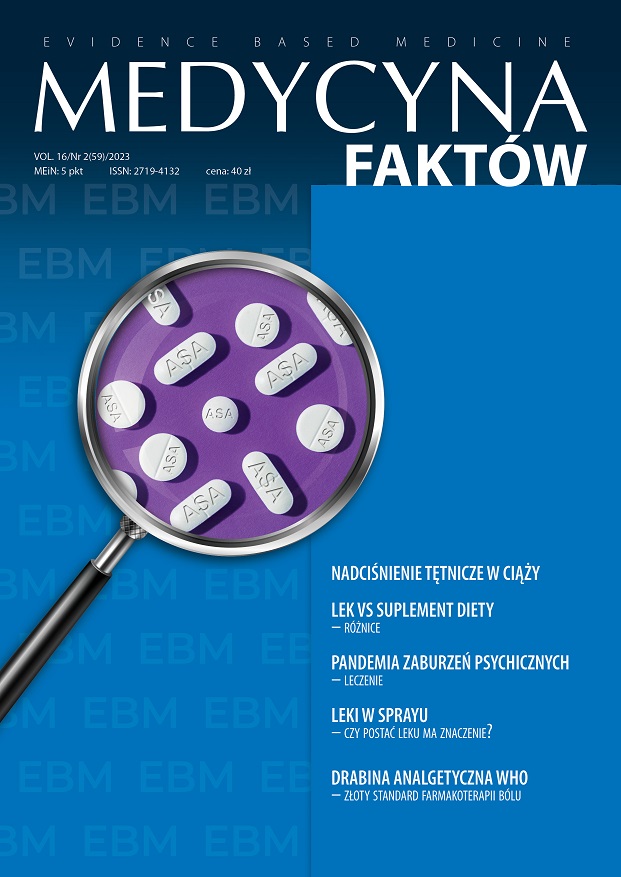The role of gepants in the prophylactic treatment of episodic migraine – part II Review article
Main Article Content
Abstract
Increasing amount of yellow adipose tissue in men leads to overweight (BMI 25–30 kg/m2) and obesity (BMI > 30 kg/m2) becoming common medical conditions and growing multidiscyplinary problem. It is crucial to define the presence of the metabolic syndrome elements and/or insulin resistance. Despite lifestyle modification: diet with a daily calorie deficit, systematic physical exercises and bariatric surgery (which we discussed in the first part of this paper), the second line of treatment is pharmacotherapy. Some medications used for treatment of other medical conditions can also contribute to weight loss, eg. medicines acting on central nervous system and used for diabetes. The knowledge of available treatment options and understanding of mechanisms underlying the disease are crucial to obtain satisfying results fighting with obesity problem.
Article Details
Copyright © by Medical Education. All rights reserved.
References
2. De Souza RJ, Mente A, Maroleanu A et al. Intake of saturated and trans unsaturated fatty acids and risk of all-cause mortality, cardiovascular disease, and type 2 diabetes: systematic review and meta-analysis of observational studies. BMJ. 2015; 351: h3978.
3. Sonestedt E, Ericson U, Gullberg B et al. Do both heterocyclic amines and omega-6 polyunsaturated fatty acids contribute to the incidence of breast cancer in postmenopausal women of the Malmö diet and cancer cohort? Int J Cancer. 2008; 123(7): 1637-43.
4. Berquin IM, Min Y, Wu R et al. Modulation of prostate cancer genetic risk by omega-3 and omega-6 fatty acids. J Clin Invest. 2007; 117(7): 1866-75.
5. Mayans L. Metabolic Syndrome: Insulin Resistance and Prediabetes. FP Essent. 2015; 435: 11-6.
6. Gartner LP, Hiatt JL. Connective Tissue. In: Cell Biology and Histology. 7th ed. Wolters Kluwer, Warszawa 2015: 94-102.
7. Tuomilehto J, Lindström J, Eriksson JG et al. Prevention of type 2 diabetes mellitus by changes in lifestyle among subjects with impaired glucose tolerance. N Engl J Med. 2001; 344(18): 1343-50.
8. Diabetes Prevention Program (DPP), NIDDK (access: 11.02.2023).
9. Xenical, European Medicines Agency (access: 6.10.2022).
10. Sjöström L, Rissanen A, Andersen T et al. Randomised placebo-controlled trial of orlistat for weight loss and prevention of weight regain in obese patients. Lancet. 1998; 352(9123): 167-72.
11. Naltrexone/bupropion for obesity. Drug Ther Bull. 2017; 55(11): 126-9.
12. Greenway FL, Fujioka K, Plodkowski RA et al. Effect of naltrexone plus bupropion on weight loss in overweight and obese adults (COR-I): a multicentre, randomised, double-blind, placebo-controlled, phase 3 trial. Lancet. 2010; 376(9741): 595-605.
13. Mehta A, Marso SP, Neeland IJ. Liraglutide for weight management: a critical review of the evidence. Obes Sci Pract. 2017; 3(1): 3-14.
14. Glucagon-like peptide 1-based therapies for the treatment of type 2 diabetes mellitus – Up-ToDate (access: 11.02.2023).
15. Wilding JPH, Batterham RL, Calanna S et al. Once-Weekly Semaglutide in Adults with Over-weight or Obesity. N Engl J Med. 2021; 384(11): 989-1002.
16. Moreno JL, Willett KC, Desilets AR. Exenatide as a novel weight loss modality in patients without diabetes. Ann Pharmacother. 2012; 46(12): 1700-6.
17. Kyrillos J. Semaglutide 2.4-mg injection as a novel approach for chronic weight management. Am J Manag Care. 2022; 28(15 suppl): S297-306.
18. Chao AM, Tronieri JS, Amaro A et al. Semaglutide for the treatment of obesity. Trends Cardiovasc Med. 2023; 33(3): 159-66.
19. de Souza A. Metformin: From medieval age to new therapeutic targets. Int J Diabetes Dev Ctries. 2008; 28(1): 31.
20. Rena G, Hardie DG, Pearson ER. The mechanisms of action of metformin. Diabetologia. 2017; 60(9): 1577.
21. Yerevanian A, Soukas AA. Metformin: Mechanisms in Human Obesity and Weight Loss. Curr Obes Rep. 2019; 8(2): 156.
22. Malin SK, Kashyap SR. Effects of metformin on weight loss: potential mechanisms. Curr Opin Endocrinol Diabetes Obes. 2014; 21(5): 323-9.
23. Bray GA, Edelstein SL, Crandall JP et al. Long-term safety, tolerability, and weight loss associated with metformin in the diabetes prevention program outcomes study. Diabetes Care. 2012; 35(4): 731-7.
24. Pu R, Shi D, Gan T et al. Effects of metformin in obesity treatment in different populations: a meta-analysis. Ther Adv Endocrinol Metab. 2020; 11: 2042018820926000.
25. Kruse T, Lerche Hansen J, Dahl K et al. Development of Cagrilintide, a Long-Acting Amylin Analogue. J Med Chem. 2021; 64(15): 11183-94.
26. Kramer CK, Leitão CB, Pinto LC et al. Efficacy and safety of topiramate on weight loss: a meta-analysis of randomized controlled trials. Obes Rev. 2011; 12(5): e338-47.
27. Smith SR, Weissman NJ, Anderson CM et al. Multicenter, Placebo-Controlled Trial of Lorcaserin for Weight Management. N Engl J Med. 2010; 363(3): 245-56.
28. Edelman S, Maier H, Wilhelm K. Pramlintide in the treatment of diabetes mellitus. BioDrugs. 2008; 22(6): 375-86.
29. Jastreboff AM, Aronne LJ, Ahmad NN et al. SURMOUNT-1 Investigators. Tirzepatide once weekly for the treatment of obesity. N Engl J Med. 2022; 387(3): 205-16.
30. Capristo E, Maione A, Lucisano G et al. Effects of weight loss medications on mortality and cardiovascular events: A systematic review of randomized controlled trials in adults with over-weight and obesity. Nutr Metab Cardiovasc Dis. 2021; 31(9): 2587-95.
31. Huixing L, Di F, Daoquan P. Effect of Glucagon-like Peptide-1 Receptor Agonists on Progno-sis of Heart Failure and Cardiac Function: A Systematic Review and Meta-analysis of Randomized Controlled Trials. Clin Ther. 2023; 45(1): 17-30.

